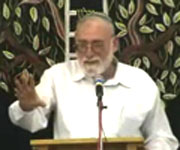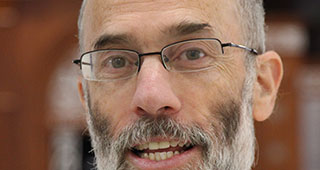Beit Midrash
- Torah Portion and Tanach
- Vayikra
- Tzav
The Torah study is dedicatedin the memory of
R. Avraham ben-tziyon ben shabtai
2. HEART OF THE NATION
3. A COMMAND AND A PLEDGE
4. RENEWED INSPIRATION
5. REKINDLED IN THE GALUT
THE FLAME
At the beginning of this week's Torah portion, Parshat Tzav - which deals at great length with the details of the korbanot, the sacrifices, the Children of Israel are commanded to ensure that a constant flame burns on the altar; the Torah stresses that "it must burn and not become extinguished." The same law is reiterated one verse later, as well.
This repetition suggests that the fire on the altar did not simply serve to cook the sacrifices offered to Hashem upon the altar; the eternal burning of the flame was crucial in and of itself, as an independent value. According to the great sage, Rambam, not even one coal of the fire may be extinguished. This held true for the entire period of the desert wanderings, as well.
HEART OF THE NATION
In order to understand the reason underlying this injunction, we must examine the essence of this fire and its role in the Beit Hamikdash (Temple). In his seminal work, the Kuzari, Rabbi Yehuda HaLevy explains that the verse, "My sacrifice, my bread, should be brought as a sweet-smelling fire" - does not mean that the sacrifices, are, so to speak, the "bread" of God; He does not need the meat of the sacrifice, God forbid! Rather, the sacrifices nurture the fire, and consequently, constitute "a sweet-smelling fire." The Mikdash, its vessels, and the sacrifices offered therein should be understood as a living example of the holy national entity of the Jewish people. The vessels symbolize different dimensions of the substance of Jewish national life - such as wisdom, wealth, etc, while the meat and meal offerings sustain our "national body." At the center of this national entity lies the living heart, the internal flame, the dynamic life pulse expressed by the fire of the altar; this fire symbolizes the heart of the entire nation, a nation with an eternal, holy yearning to come to truly know the Holy One, Blessed be He.
It is in this sense that the sacrifices are "My fire," the fire of the Master of the Universe that burns within our souls. The heart allows us to live, nourishment provided the body are transformed into blood, pumped by the heart to the rest of the body.
A COMMAND AND A PLEDGE
From the midrash and other texts elucidating this week's Torah portion, we learn that the eternal flame on the altar constitutes both a commandment and a Divine pledge. In other words, God promises us that the life force of the community of Israel, burning inside us, simply cannot be extinguished. It is completely eternal; none of our external enemies can extinguish it. Moreover, no internal weaknesses can put out the flame, either. "Neither rushing waters nor rivers can extinguish the love" (Shir HaShirim/Song of Songs). The love song of Shir Hashirim is continual, uninterrupted, forever on the rise, overcoming all obstacles.
The flame, the passionate love between the community of Israel and its God, exists (albeit in a more hidden fashion) during the long years of the exile, with the flames of this love rising higher as the redemption approaches. It also manifests itself in the private lives of each individual Jew. According to the Sfat Emet, "every member of the Jewish people must believe that he possesses a hidden spark of burning love for Hashem, a fiery cleaving that can never be extinguished..." Each one of us is a link, a limb of Klal Yisrael; this flame burns within each one of us, in some of us more openly, in others - in a more hidden fashion.
RENEWED INSPIRATION
When a person leads a healthy life, allowing his true energies and personality to show themselves, he acts according to nature; he lives a holistic life of Torah, without any admixture of superficiality or rote; he performs acts that have inherent value, he thinks pure thoughts. In short, the original design that God had for life is preserved: "Because God Created man upright.."
We can all look at our lives as both the continuation and fulfillment of God's act of creating man. This is true of the individual, and also of the nation as a whole. The Beit Hamikdash was characterized by one long chain of relatedness; it was the place in which the human and Heavenly fires met. "Even when the fire descends from on high, it is a mitzvah for man to also light a flame." It is a mitzvah to renew oneself, to stir up within oneself anew love and belief in God. The absolute, "Tamid" - or ongoing Divine reality - must reflect itself in the continual unearthing of an internal, self-renewing drive to serve the Creator.
The Rishonim note that the third Beit Hamikdash will descend to the earth from Heaven -a fiery, already built, highly sophisticated Temple - as it says, "Your hands, Hashem, fashioned a Mikdash." In the book of Zecharia, chapter two, the prophet records the following Divine statement: "And I will, be, says the Lord, a wall of fire all around, and I will be honored therein..."
On the other hand, the most accepted view is that the Temple's construction is incumbent upon us to carry out; it is a mitzvah for generations, and we are bound to fulfill it with our own hands, as the Rambam asserts, and as the approach of the Talmud seems to indicate.
The author of the Talmudic work "Aruch L'ner", in his commentary on Tractate Succah, reconciles the two approaches. He says that we are commanded to build the Mikdash - and it will, in fact, be rebuilt by man; as soon as it is built, however, a second, spiritual Beit Hamikdash will descend from Heaven, a Divinely-fashioned Temple that will dwell within the man-made Mikdash, like a soul resting in a body. This parallels the concept mentioned earlier, that the fire from Heaven comes alongside the sacrificial fire lit by man...
REKINDLED IN THE GALUT
In the depths of the Egyptian exile, Moshe Rabeinu guides the sheep of his father-in-law, Yitro towards the desert; there, on the Divine Mountain (Mt. Sinai) an angel of God reveals himself in a fire, from the midst of a bush. The goal: to announce that God would redeem His people and bring them eternal freedom. According to the Sfat Emet, from the midst of the complex, thorny, dark Galut and all it entailed, Moses perceived the hidden, internal Jewish flame...
This was apparently a reflection of the concept of a Heavenly flame, a Divine fire that burned within the hearts of Israel, even without their conscious knowledge that it was there, ever-present. On Shabbat HaGadol, the Sabbath before Pesach, when the Israelites ignored the threat to their safety, by setting the Paschal lamb aside to be sacrificed in response to God's command, the human-ignited flame was lit, merging with the more hidden Divine flame.
The midrash also hints at this theme. According to the Mechilta, "our forefathers had three altars - the lintel and the two doorposts." In other words, the home of each and every Jew in Egypt functioned as an altar, with the lintel and doorposts replacing the corners of the altar as the sites for the sprinkling of the blood of the sacrifice. The taking of the Paschal lamb was the action that turned the home into a ritual altar, such that the Divine fire could settle in on each home, to facilitate the acceptance of the Pesach sacrifice and consequently to allow for the Redemption of the Israelites from Egyptian bondage.
Tzav – An Officer's Command
Rabbi Berel Wein zt"l | Nissan 9 5781
Vengeance as the Foundation of the Nation and Faith
Rabbi Yechezkel Frenkel | Nissan 9 5783
Dress Appropriately!
The Wisdom of Rabbi Moshe Feinstein (16) - Tzav
Rabbi Baruch Finkelstein | 10 Nissan 5773






















